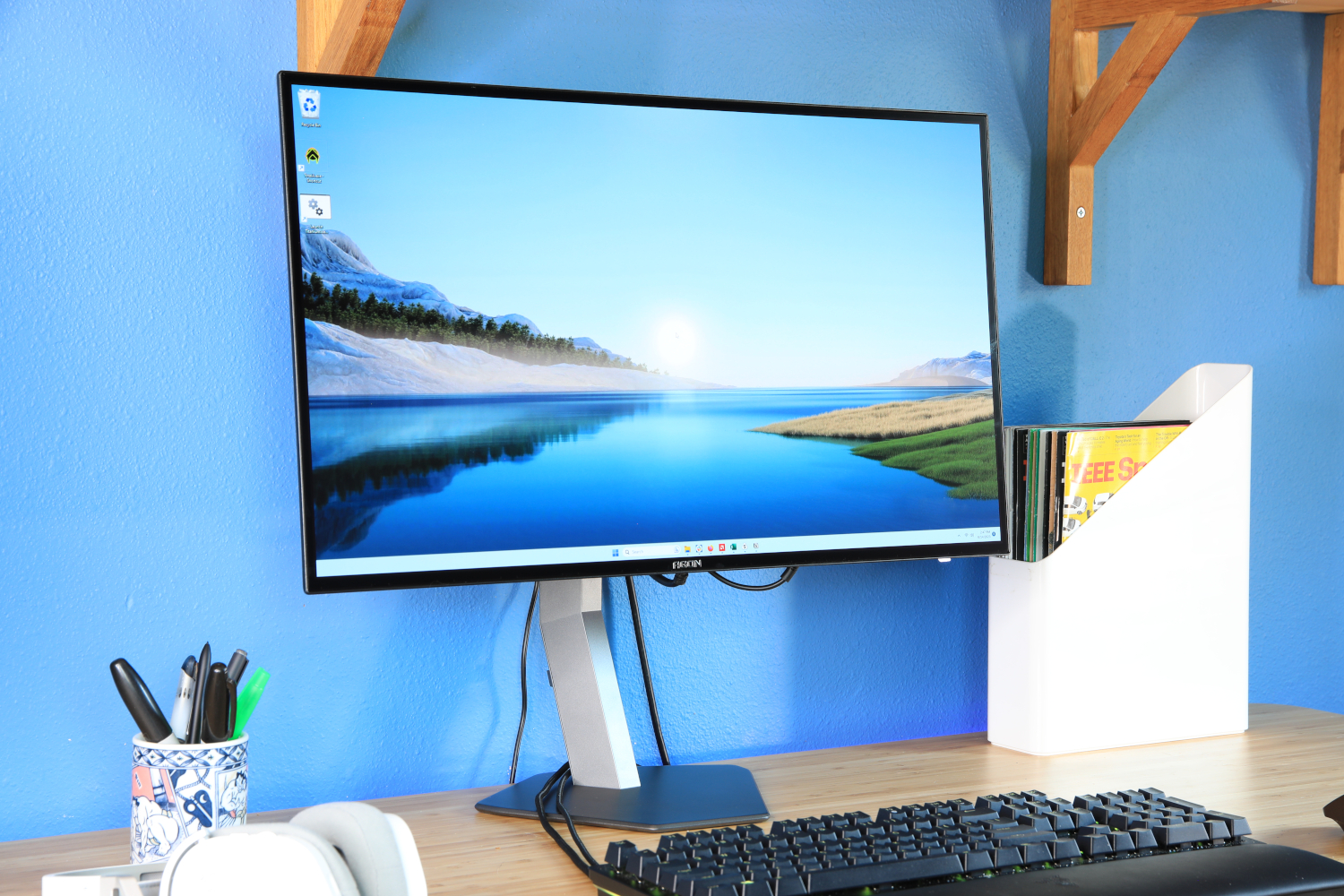

AOC is the latest to enter the progressively competitive field of 27-inch, 1440p, 240Hz OLED video gaming monitors. The Agon Pro AG276QZD attempts to set itself apart with a special, uneven style and great connection, but image quality quirks keep back the AG276QZD’s potential.
AOC Agon Pro AG276QZD: What are the specifications?
If the AOC Agon Pro AG276QZD’s specs feel a bit familiar, well, that’s no surprise. The recent flood of 27-inch, 1440p OLED gaming keeps track of depend on a particular LG Paper White panel matched to computer screens.
Display size: 26.5-inch widescreen
Native resolution: 2560 × 1440.
Panel type: OLED.
Revitalize rate: 240Hz.
Adaptive Sync: G-Sync compatible.
HDR: Yes, HDR10.
Ports: 2x HDMI 2.0, 2x DisplayPort 1.4, 2x USB-A 3.2 Gen 1, 3.5 mm audio-out.
VESA mount: Yes.
Speakers: Yes, 2x 5-watt.
Cost: $999.99.
That makes it tough for any one screen to stand apart, and the AG276QZD is no different. Its size, resolution, and revitalize rate precisely match contending screens from LG, Corsair, Asus, and Acer.
AOC needs to’ve understood the Agon Pro AG276QZD’s technical similarities to its competition, since the company goes wild with the monitor’s style.
The display screen’s look focuses on an uneven pentagon shape found on both the display’s rear panel and the display stand. It’s a vibrant alternative to the classic symmetric shapes used by the majority of rivals. AOC includes focus with adjustable RGB-LED lighting on the back of the display. The light’s aren’t bright, however, so they just jump out in a dark room.
AOC’s asymmetric design continues with the compact stand base. Looks aside, the stand’s small, slim profile is good news for gamers with minimal desk area.
The stand attaches to the screen with a clip mechanism instead of a VESA mount. The display panel itself is VESA suitable, so a third-party display arm or stand remains a choice.
AOC Agon Pro AG276QZD: Features and menus.
A set of HDMI 2.0 ports and DisplayPort 1.4 ports hide behind the AOC Agon Pro AG276QZD’s rear panel, providing a total of four video inputs. That’s excellent for any gaming screen, and a minor enhancement over the options, which typically have 3 video inputs.
Only the DisplayPort 1.4 inputs can deal with the screen’s 1440p resolution at its optimum refresh rate of 240Hz. The HDMI 2.0 ports are limited to 1440p at 144Hz. AOC’s rivals share this issue.
USB-C connection is restricted to two USB-A 3.2 Gen 1 downstream ports powered by a single USB-B upstream. This isn’t a great deal of USB connectivity– however, again, it’s comparable to the competition. If you desire USB-C, think about the Corsair Xeneon 27QHD240.
AOC’s menu system is adequate, but only just. A joystick on the monitor’s best rear flank provides quick, responsive access to the menus. However, the menu system’s plan can prove confusing. Some menu options are changed with a left/right motion, while others use an up/down movement. The absence of consistency can cause mistakes.
The screen consists of numerous color modes, color temperature, and color gamma presets, but a lot of are not calibrated to a specific target. AOC chucks in gaming-centric features, like a crosshair and personalization of the “LightFX” RGB-LED lighting on the screen’s back panel.
Speakers are bundled in the AG276QZD, but don’t expect to count on them. They deliver thin, hollow noise that’s quickly overwhelmed by bass. They’re alright for podcasts, but music, video games, and films can sound extreme, metal, and grating.
How is the AOC Agon Pro AG276QZD’s SDR image quality?
The AOC Agon Pro AG276QZD’s 27-inch 1440p panel supplies the technology needed to provide top-tier image quality. It measures up to expectations in some areas, but stumbles in others.
Brightness is an unsurprising constraint of the AOC Agon Pro AG276QZD. All displays based on the LG Paper White OLED panel have issues in this area. That said, a brightness of 244 nits is usable in the majority of scenarios, and I typically left the display at approximately 50 percent of its optimum. Brightness is only a problem when the monitor is used in an incredibly intense space or near a sunlit window.
The AG276QZD delivers on OLED’s promised contrast with a successfully limitless contrast ratio. This occurs because the monitor can deliver a brightness of precisely absolutely no nits when needed.
Unlimited contrast results in an abundant, immersive experience. There’s a real sense of depth and dimensionality to high-resolution, contrast-rich content. This, along with the display’s thin bezels, can make it appear as if you’re browsing a window, not at a display screen.
Dark, moody material excels, as there’s no hint of the grayish glow typical to most monitors. Shadow detail is well protected, too, so subtle figures and silhouettes stay visible in dim scenes. That’s beneficial when playing games like Diablo IV or Left 4 Dead 2, and when viewing poorly lit movies such as The Batman.
Color gamut is where AOC’s fortunes begin to turn.
The AG276QZD offers a color range that covers 100 percent of sRGB, 91 percent of AdobeRGB, and 87 percent of DCI-P3. The same is real of AOC’s Agon Pro AG274QZM, a Mini-LED option.
And color accuracy is where the story truly sours. The AG276QZD scored rather inadequately in color precision with a typical color mistake far beyond any of its alternatives.
I’ve evaluated enough keeps an eye on based on LG’s Paper White panel to, at this point, call frustrating color precision a typical problem for this panel type. The AG276QZD is the worst of the lot, however, and it reveals.
Colors tend to appear overly saturated and neon-like on the AG276QZD. This is most obvious in yellow, which tends to move towards an unnatural yellow-green hue, however I saw a similar over-saturated skew present in cyan and magenta. I tried to tame this impact with the screen’s color calibration features, but with minimal success.
Just how much this matters depends on how you plan to use the screen. Players most likely won’t notice anything awry. A somewhat over-saturated and vivid appearance can seem subjectively much better in games, even when it’s not technically accurate. If you’re a content developer who deals with images, video, or digital art regularly, nevertheless, give the AG276QZD a pass.
I also observed the screen’s default gamma was off at a reading of 1.9. This suggests images appear a bit more luminous than they should. Color temperature level was acceptable, though, with a reading of 6800K (just a little cooler than the wanted 6500K).
The majority of OLED screens presently available have a sub-pixel design that varies from the RGB layout Windows expects, which leads to color fringing problems around high-contrast borders. When reading a great text, for example, you may see the space between letters or digits has a jagged and somewhat shady look.
How is the AOC Agon Pro AG276QZD’s HDR image quality?
The AOC Agon Pro AG276QZD supports HDR but, unlike its competitors, it’s not VESA DisplayHDR 400 True Black certified. This shows less important than you may believe, however HDR efficiency is disappointing.
That’s since the AG276QZD, like all OLED screens, has trouble attaining and sustaining a high level of brightness. I measured an optimum HDR brightness of 224 nits (a bit less than SDR, really). That’s way below the 600 to 800 nits needed for a passable HDR experience. In real-world viewing, the display’s minimal brightness indicates bright areas of an image that need to expose more information instead appear washed-out and uniform.
I likewise observed the typical concerns with SDR tone mapping when HDR is turned on in Windows. SDR material seen on the Windows desktop will appear less color accurate when HDR is turned on. Many monitors share this issue, and it’s definitely visible here.
No OLED gaming screen on the marketplace today is a fantastic choice for HDR material. Still, the AG276QZD’s general performance is lackluster. In basic, gamers who wish to utilize HDR on an OLED gaming screen need to look towards display’s with Samsung’s QD-OLED panel, such as the Alienware AW3423DWF and Samsung Odyssey G8 OLED, as they deliver exceptional peak brightness.
How is the AOC Agon Pro AG276QZD’s motion performance?
Movement clarity is an undeniable win for the AOC Agon Pro AG276QZD. It provides the killer combo: a 240Hz refresh, extremely low pixel response times, and Nvidia G-Sync support.
The 240Hz revitalize rate provides buttery-smooth gameplay with a tight, crisp response to user input. Given, the game you’re delighting in will need to render at 240 frames per 2nd to completely use this feature, however the display’s 1440p resolution (which demands less of a video card than 4K resolution) makes this achievable in esports titles on midrange graphics hardware.
Low pixel action times assist take advantage of the 240Hz refresh rate. OLED panels can achieve reaction times down to 0.03 milliseconds gray-to-gray. This results in less motion blur, as pixels “react” to changes in color quickly. While this is useful at 240Hz, it likewise uses at lower refresh rates, which comes in handy if you take pleasure in requiring video games that dip your frame rate into the double-digits.
Official Nvidia G-Sync support is appreciated, too. There’s nothing wrong with AMD FreeSync however, as Steam’s hardware survey explains, many PC gamers select an Nvidia graphics card. And there’s a reward: though not officially listed, AMD FreeSync Premium when I linked the screen to an AMD Radeon 6600 video card.
The AG276QZD’s excellent motion clarity isn’t unusual for the classification. All 27-inch, 1440p, 240Hz OLED screens attain similar outcomes. Still, the movement clearness offered here makes certain to please both casual and competitive gamers.
Is the AOC Agon Pro AG276QZD worth it?
The AOC Agon Pro AG276QZD has a smart design and excellent feature set for a 27-inch 1440p OLED monitor, however it feels like an also-ran in the category.
Alternatives like the Corsair Xeneon 27QHD240 deliver much better general image quality with a side of USB-C connectivity. The real threat, nevertheless, is the Alienware AW3423DWF and Samsung Odyssey OLED G8: these 34-inch ultrawides provide a larger display, better color performance, and brighter HDR at a comparable rate.
If you’re not devoted to OLED, the AOC Agon Pro AG274QZM is an engaging alternative. Priced just $50 higher, this Mini-LED display scores wins in brightness, color efficiency, sharpness, and HDR image quality.
The AOC Agon Pro AG276QZD is a good OLED gaming monitor however, absent a major discount, it’s hard to advise over the alternatives.








